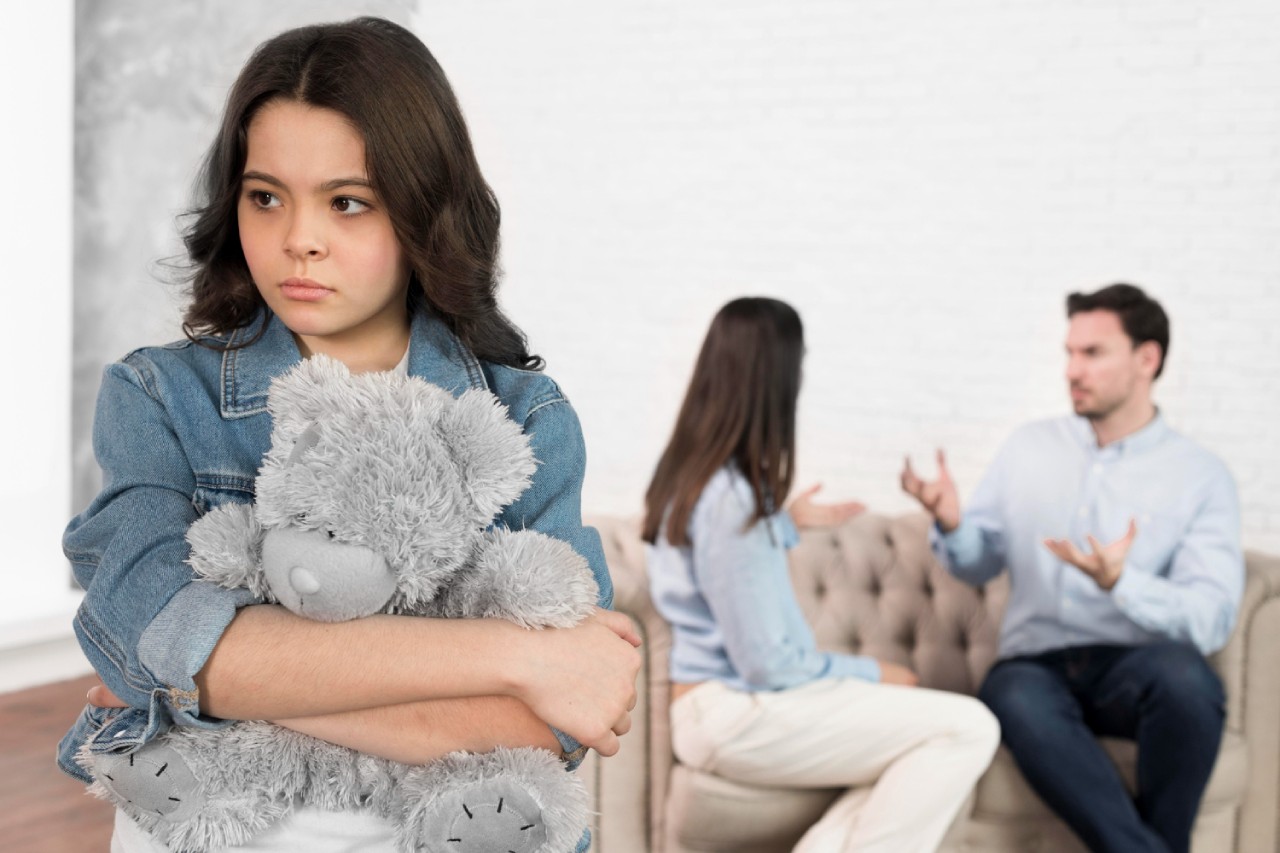Childhood trauma can shape how people perceive themselves, other people, and the world they live in.
The Link Between Childhood Trauma and Adult Relationships
Harmful experiences, even those that happened in childhood, can still affect you today. Oftentimes, we don’t even realize the lingering impact because the trauma exists in our subconscious. One out of three children will have at least one stressful or traumatic childhood experience, including things such as their parents divorcing or a family member with a drug or alcohol problem, according to the latest National Survey of Children’s Health.
People who’ve experienced trauma as a child may end up settling for a partner who is not a good match for them. They may avoid relationships altogether, believing they don’t deserve love. Or they may sabotage a relationship, pushing the other person away so that they don’t have to risk getting hurt later on. The good news is that behavior patterns like this can be changed. Self-reflection through therapy, journaling, and self-care can help you heal.
Common Types of Childhood Trauma
Childhood trauma is a general, umbrella term that refers to any significantly distressing experience someone may have been exposed to as a child.
Examples Include:
- Physical Violence
- Sexual Abuse
- Natural Disasters
- Loss of a loved one
- Abandonment
- Foster Care
- Any other situation where the child felt scared, helpless, uncared for, or overwhelmed
Childhood trauma can be trapped in our bodies, impacting our behaviors and relationships throughout adulthood. Those who experience a trauma in childhood are more likely to have dysfunctional romantic relationships as adults. One reason is that they learned to mimic the unhealthy behavior that their caretaker(s) displayed. Another reason is that the now adult unconsciously seeks out partners who have similar traits to their caretaker, including the harmful behavior.
Signs of Childhood Trauma
How one behaves in an adult, romantic relationship may be a clue to whether they experienced trauma as a child. Childhood trauma can show up in romantic relationships in subtle and overt ways. Often, the individual doesn’t even realize their behavior is connected to their early experiences.
Ways That Childhood Trauma Can Manifest In Adult Relationships:
Fear of Abandonment
This is a fear of being left behind or a fear that people will not stay, especially when a relationship becomes more serious and requires vulnerability. Fear of abandonment often stems from a relationship with a caregiver who abandoned them in some way, whether perceived or real. Examples of abandonment include childhood neglect from primary attachment figures, whether physical or emotional in nature, the death of a significant caregiver, or divorce.
When a child experiences abandonment trauma, they may learn to believe that they can’t rely on others to have their needs met. This belief then interferes with their ability to form healthy relationships with others. If a child has a caregiver who is unresponsive, preoccupied, or uncaring, the child then believes that they are not good enough and that people will leave them in the end. As a result, they make it their mission to prevent them from going. This sometimes manifests as clinginess.
Fear of abandonment may cause them to need constant reassurance from their partner. For example, they may repeatedly ask, “Are you mad at me?” They may overanalyze everything due to their rejection anxiety, like text messages. Ironically, the behaviors intended to make a partner stay can become the reasons why they leave. Their actions turn their worst fears into reality and end up confirming their belief that people will leave them.
Low Self-Esteem
Someone who felt devalued as a child may feel unworthy of love or affection as an adult. This can cause them to close themselves off from romantic relationships. Alternatively, their lack of self-esteem may cause them to settle for an unhealthy, toxic relationship.
Control Issues
Someone with childhood trauma may develop control issues that can impact a romantic relationship. Trauma can lead to a sense of helplessness and a need to regain control, resulting in either a fear of losing control or a compulsive need to control everything. Issues with control can cause a person to be overly jealous in a relationship.
Constant Arguing, or Avoiding Conflict
If a person grew up in a household where there was constant fighting, they probably did not develop productive communication skills. The same can likely be said for children in a home where conflict was avoided at all costs. There is a much higher chance that the now adult will mimic similar behavior.
Not Knowing How to Repair
Similarly, when we don’t learn how to manage conflict in a healthy way, we can’t know how to repair after, either. Repairing after a fight is what restores the connection. Repairing consists of acknowledging the conflict and discussing it openly. This means being vulnerable. It means taking responsibility where it is due and being open to compromise. Repairing is a skill. Without it, the person may fail to acknowledge anything that transpired or engage in the silent treatment, both of which will exacerbate future conflict.
Serial Monogamy
Some adults with childhood trauma jump from relationship to relationship because of their strong fear of being alone. Relationships may not last long due to communication issues. Specifically, they may struggle with expressing their needs and emotions, resulting in misunderstandings and conflict. The same patterns may play out from one relationship to the next.
Trust Issues
Trust issues are one of the most common effects of childhood trauma. When a child experiences trauma, they may learn that the people they’ve trusted the most – parents or caregivers- can hurt them. This can lead to significant difficulties trusting others in adulthood, making it hard to form meaningful connections.
Their Trust Issues May Cause Them To:
- Be suspicious or jealous without due cause
- Monitoring their partner’s whereabouts or phone
- Prevent them from being happy in the relationship because they are constantly worrying that it will end
The truth is that you cannot have a healthy relationship without trust. In fact, lack of trust is one of the top reasons why relationships fail, according to a 2019 study.
Boundary Issues
When we set and hold healthy boundaries, we value ourselves. Boundaries can pertain to time, physical space, emotional space, material possessions, and sexual intimacy. Someone with boundary issues may:
- Let their partner cross lines to avoid being abandoned
- Feel guilty for saying no or having personal space
- Be confused about where you end and your partner begins (known as enmeshment)
Issues With Sex
Childhood trauma, particularly sexual trauma, can disrupt the normal development of sexual responses and lead to various sexual dysfunctions such as problems with desire, arousal, orgasm, and pain during intercourse. Talking about sex or expressing what they want in the bedroom might make them extremely uncomfortable.
- Using sex as a way to feel accepted
- Feeling disconnected or detached from one’s body during sex
- Avoiding sex due to fear, shame, or trauma triggers
- Confusion between love, attention, and sexual validation
Struggles With Intimacy
Sex isn’t the only type of intimacy. Emotional intimacy is another type of intimacy that is extremely important for maintaining a strong connection. Someone who had an unhealthy relationship as a child may now have an aversion to emotional vulnerability, an uneasiness with closeness, or a constant need for reassurance.
Examples include:
- Prioritizing independence to a level where there’s no room for intimacy
- Avoiding being vulnerable: shutting down in conflict or not sharing anything deep about themselves
Trauma Reenactment
Trauma reenactment, also known as repetition compulsion, involves repeatedly engaging in behaviors or seeking experiences that echo early life experiences, even if they cause distress. It seems that traumatized individuals tend to have a sort of addiction to trauma. Multiple studies show that retraumatization and revictimization of people who have experienced trauma, especially trauma in childhood, are all too common. An example would be actively seeking out relationships that mirror the abusive patterns that they experienced as a child.
Impact of Childhood Trauma on Adult Attachment Styles
The APA (American Psychological Association) defines an attachment style as the characteristic way people relate to others in the context of intimate relationships, which is heavily influenced by self-worth and interpersonal trust. In other words, a person’s sense of security in a relationship is their attachment style.
What we want is a secure attachment. We can develop a secure attachment style if we are raised in a safe, secure, loving, and nurturing environment.
A person with secure attachment:
- Regulates their emotions well
- Has a positive view of self and others
- Communicates in healthy ways
- Confiedent and resilinet
- Sets and maintains healthy boundaries
- Open and trusting
- Able to argue productively and repair after
In childhood, trauma disrupts the development of secure attachment—the ability to trust others, feel safe in connection, and regulate emotions. Trauma in childhood leads a person to develop an insecure attachment, of which there are three types: anxious, avoidant, and disorganized.
Anxious Attachment
Someone with an anxious attachment style is constantly worried about their relationship. While it can seem great how much they care about the relationship, they’re focused on the negative.
Usually, people with an anxious attachment style have a fear of rejection and abandonment. They are constantly seeking validation. Their relationships may even turn codependent.
A partner with an anxious attachment style is always scanning your behavior and interactions, looking for signs that you may not love them anymore. They may think you will abandon them at any point. Therefore, it’s like they can never relax, and they may never feel satisfied in the relationship.
How An Anxious Attachment Style Develops:
Anxious attachment style stems from inconsistent parenting that is not attuned to a child’s needs. At times, the caregiver will be supportive and responsive to the child’s needs, while at other times, they will be unavailable or unable to satisfy what the child needs. Neglect, abuse, or unstable family environments can all lead to anxious attachment in adulthood.
Another cause linked to the development of an anxious attachment style is having a caregiver with a so-called “emotional hunger”. This is when the parent is prioritizing their own needs through their child. It is confused with genuine care or love, but in reality, the child is being neglected and used.
Avoidant Attachment
This insecure style is also known as dismissive attachment. Avoidant attachment is characterized by a strong sense of self-sufficiency, often to the point of appearing detached. People with dismissive attachment value their independence and may appear uninterested in forming deep connections. In contrast to anxious attachment, a person with an avoidant style holds a positive view of themselves and a negative view of others.
How An Avoidant Attachment Atyle Develops:
An avoidant attachment style is the result of the early caregiver ignoring the child’s emotional needs. The child is essentially neglected altogether. The child ends up feeling unloved and uncared for. This forces the child to distance themselves emotionally and find ways to self-soothe.
Disorganized Attachment
Disorganized attachment, also known as fearful-avoidant attachment, is characterized by inconsistent behavior. This style incorporates elements from both the anxious and avoidant attachment styles. The person may switch back and forth between the two types. A person with disorganized attachment will have issues opening up and trusting others. Often, they struggle to regulate their emotions and can become easily overwhelmed. They may have a harder time socially due to problems with effective communication.
How A Disorganized Attachment Style Develops
The disorganized attachment style is said to be the result of abuse or trauma in childhood. It can also be the result of being afraid of the caregiver. The caregiver may be abusive but also do things to meet their needs, making it a confusing relationship. The caregiver is both a source of comfort and fear.
The child may have experienced verbal, physical, or sexual abuse. Or they may have witnessed a parental figure committing a traumatizing act, such as one caregiver hitting another caregiver. A different example of trauma could be from a parent or caregiver who drinks heavily, regularly disappears, or passes out, leaving the child without basic needs. A child raised in a home like this saw two very different sides of their caregiver, and their behavior was unpredictable. The child couldn’t predict if they’d get the loving parent or the one who was dangerous. This made it impossible for the child to feel safe.
Emotional and Behavioral Patterns Resulting from Trauma
The Role of Childhood Trauma in Emotional Regulation
Influence on Sexual Intimacy and Relationships
Self-Advocacy and Relationship Quality
Therapy
The damage from childhood trauma is far-reaching. No, trauma is not your fault. Yes, it can negatively affect romantic relationships, but the relationship that is hurting most is the one with yourself. The love and respect for ourselves, or lack thereof, directly impacts our relationships with others.
Often, we don’t fully recognize all the ways that childhood trauma is lingering and affecting adulthood. Therapy can be a powerful way to help heal from childhood trauma.
5 Ways Therapy Can Help Heal Childhood Trauma:
- Understand The Impact: Therapy helps us see the connection between past events and present behaviors and emotions. Therapy can allow you to recognize the ways in which you are affected by a trauma response that you weren’t even aware of.
- Reprocess The Trauma: Therapeutic techniques such as EMDR (Eye Movement Desensitization and Reprocessing), IFS (Internal Family Systems), or Trauma-Focused CBT help rewire the way your brain stores traumatic memories.
- Rebuild Self-Compassion: Childhood trauma often leads to self-blame or shame. Therapy can help you view yourself with empathy, instead of judgment.
- Set Boundaries & Emotional Regulation: Therapy can provide guidance when it comes to developing healthy boundaries as well as strategies for managing emotions.
- Reparent The Inner Child: Learning to lovingly care for and meet your own needs.
Inner Work
Write About It
Writing down your feelings is a productive way to get those feelings out of your body. You can start by acknowledging your trauma. Put your early memories on paper. Write about how it made you feel.
Write a letter to yourself as a child offering them the love, safety, and understanding they didn’t receive. You are attempting to connect with and reparent your inner child.
Learn About Trauma
Understanding trauma can be extremely helpful in terms of healing your own individual trauma.
Books by trauma experts include:
- “The Body Keeps The Score” by Dr. Bessel van der Kolk
- “Attached” by Dr. Amir Levine and Rachel S.F. Heller
- How to Do the Work” by Dr. Nicole LePera
Body Work:
Trauma can cause unprocessed emotions to be trapped in our bodies. Instead of numbing those feelings or allowing them to fester, we can release them in healthy ways such as:
- Mindful breathing and full body scans
- Somatic practices like TRE (tension & trauma release exercises) or gentle movement
- Naming emotions without judgment

 Call Us Now
Call Us Now



